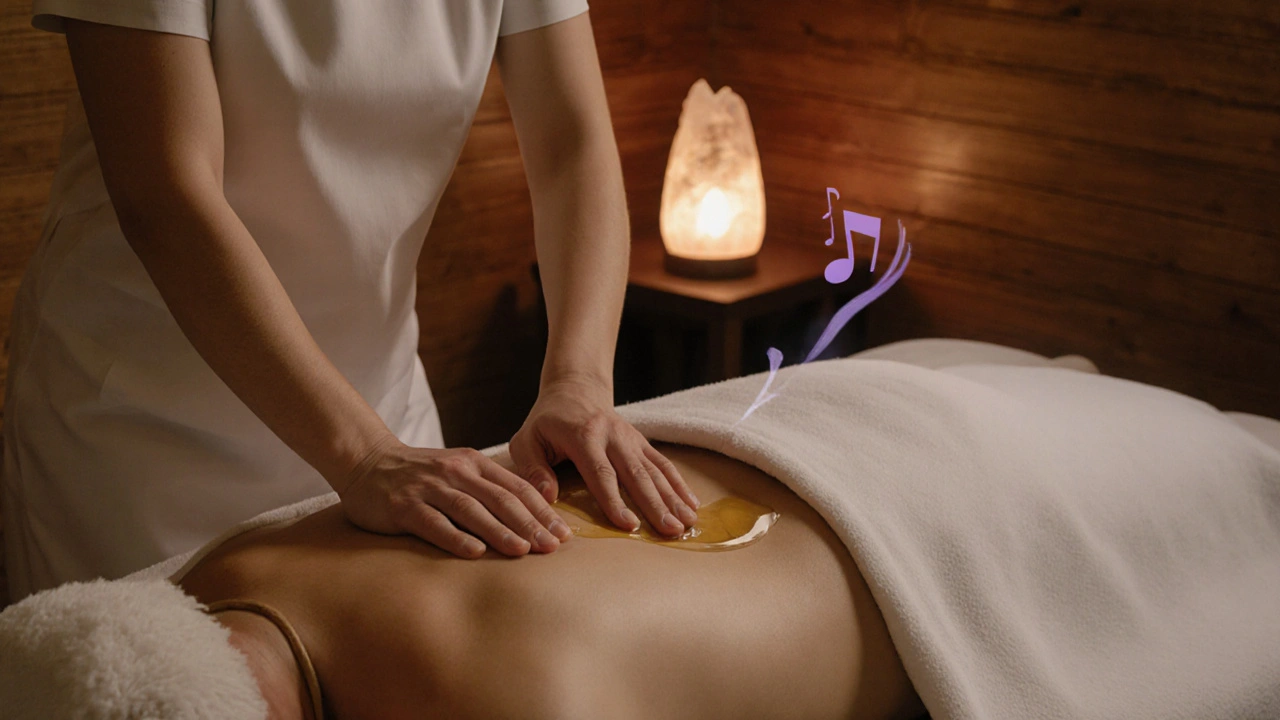Why Body Massage Is the Best Gift You Can Give Yourself

If you’ve ever thought massage is just a luxury, you’re in for a surprise. It’s so much more than lying on a table and zoning out. Regular body massages help you sleep better, boost your mood, and knock down stress like a pro. Ever come home so tense your shoulders feel like rocks? Massage can help melt that tension fast.
What I love about massage is how it brings your focus back to your body. Even a short session can work wonders on stiff muscles or a mind that refuses to turn off at night. If you’re thinking this sounds good but not sure where to start, don’t worry—we’ll break down the easiest ways to find the right massage, what to expect, and the best ways to enjoy every minute.
Ready to give yourself a break that actually makes a difference? There’s a perfect massage just waiting to become your new go-to ritual for feeling great.
- Main Benefits of Body Massage
- Popular Types of Massage
- How to Choose the Right Massage Service
- Insider Tips for First-Timers
Main Benefits of Body Massage
Body massage does more than just make you feel good—it’s a health upgrade in disguise. If you’re juggling work, family, or endless to-do lists, chances are you’re carrying stress somewhere in your body. A great massage can help break that cycle and put you back in control.
Here’s how body massage can make a real difference:
- Body massage lowers stress: Cortisol is your body’s stress hormone, and studies show regular massage sessions can drop cortisol levels by up to 31%. That means less tension, fewer mood swings, and way better sleep.
- Improves blood flow: Massage gets your circulation going. Better circulation means more oxygen and nutrients get to your muscles, helping you heal faster after workouts or long days at your desk.
- Fewer headaches: If you get tension headaches or migraines, massage can help dial back those nasty flare-ups. When your shoulders and neck loosen up, your head follows.
- Boosts your immune system: Research shows people who get massages regularly produce more white blood cells. Those are your body’s defenders against germs and illness.
- Better flexibility: Tight muscles can lead to aches and even injury. Massage helps your body move more freely, whether you’re running marathons or just chasing your kids around.
- Instant relaxation: Even a 30-minute massage can help turn off that “busy brain” feeling and give you a true break—one you actually feel in your body, not just your mind.
Take a look at this quick breakdown of what massage can do for you based on data from recent studies:
| Benefit | Average Improvement After 1 Month of Weekly Massage |
|---|---|
| Reduced Stress (Cortisol) | ↓31% |
| Improved Sleep Quality | ↑28% |
| Fewer Headaches | ↓23% |
| Muscle Flexibility | ↑30% |
| Immune Function | ↑18% |
So if you’re wondering if booking that session is really worth it, just remember: your body and mind get a lot back from even one massage. Make it a habit, and those benefits only stack up.
Popular Types of Massage
Choosing the right massage might feel overwhelming since there are so many out there. So let’s keep it simple and run through the top picks you’re most likely to find—plus what each is best for. Think of this as your cheat sheet for everything from full-blown relaxation to sorting out stubborn knots.
- Swedish Massage: This is the classic one people think of first. It uses long, gentle strokes, and it’s perfect for relaxing, improving blood flow, and easing light muscle tension. If you’re new to body massage, start here.
- Deep Tissue Massage: Go for this if you’ve got serious tightness or chronic pain in spots like your neck or back. Therapists use slow, deep pressure to target those stubborn sore points. Sometimes it hurts so good, but you’ll feel loose and limber after.
- Sports Massage: Athletes swear by this one. Sports massage helps prep muscles before a workout or helps recover faster after. Even if you’re not an athlete, but you’re active, this can be a game changer.
- Hot Stone Massage: Smooth, heated stones get placed on your back and used as an extension of the therapist’s hands. This combo sends tension packing and feels soothing, especially in winter or after a tough week.
- Thai Massage: If you don’t mind a little active movement, Thai massage is basically yoga with a partner. The therapist will stretch and move your body in different ways, so wear comfy clothes. Great for flexibility and energy boosts.
- Aromatherapy Massage: Scented oils turn a regular massage into a total mood makeover. Choose calming lavender or energizing citrus to boost your session with the power of scent.
As Dr. Tiffany Field from the Touch Research Institute says,
“Massage therapy offers proven benefits for stress management, pain reduction, and mental well-being.”So you’re not just feeling good in the moment—you’re actually making real improvements to your health.
| Type of Massage | Best For | Typical Duration |
|---|---|---|
| Swedish | Relaxation, first-timers | 60–90 min |
| Deep Tissue | Chronic pain, muscle tension | 60–90 min |
| Sports | Active people, injury recovery | 30–60 min |
| Hot Stone | Deep relaxation, muscle tension | 75–90 min |
| Thai | Flexibility, energy, active stretching | 60–90 min |
| Aromatherapy | Mood-boost, relaxation, stress | 60 min |
Most places let you tailor your sessions, so don’t be afraid to ask for what you need. Whether you want pure chill time or something to fix creaky joints, there’s a style of body massage that fits your life perfectly.

How to Choose the Right Massage Service
Picking the right place for a body massage isn’t always as easy as searching ‘massage near me’ and picking the first one. You want a spot that not only feels safe and welcoming but also has therapists that know what they’re doing. Here’s what you should keep an eye out for.
- Check Qualifications: The best therapists are certified or licensed (you can ask to see their credentials—don’t feel weird about it). In the U.S. alone, more than 300,000 massage therapists are licensed, but not every facility checks backgrounds thoroughly.
- Type of Massage: Make sure the spot offers what you need—Swedish, deep tissue, sports, or a specialty massage. Good places list their services clearly on their website or menu.
- Cleanliness: Trust your gut when you walk in. Look for freshly cleaned sheets, tidy waiting areas, and proper hygiene practices. No one wants to relax in a sketchy room.
- Reviews and Ratings: Online reviews matter. Google, Yelp, and even Instagram can give you a good idea of others’ experiences. High-rated places rarely disappoint.
- Pricing Transparency: Some places tack on random fees. Make sure rates are upfront and there are no surprise charges at checkout.
- Communication: Your therapist should ask about the pressure you like and if you have any pain points. If they don’t, that’s a red flag.
Sometimes it helps to call ahead and ask a couple of questions or even drop in to scope out the vibe. If you’re really unsure, start with a shorter session to test things out before committing to the full hour.
Here's a quick table to keep things clear when you compare places:
| Criteria | What to Look For |
|---|---|
| Certification | Licensed/certified therapists |
| Types of Massage | Clear service menu, specialties offered |
| Cleanliness | Fresh linens, clean rooms |
| Reviews | Consistent 4+ star ratings, positive comments |
| Pricing | No hidden fees, clear costs on website |
| Communication | Therapist asks about needs/comfort |
If you’re booking online, look for easy scheduling and confirmation emails—this shows the place is organized. For busy neighborhoods, try to book a couple days ahead. If you find a spot you love, rebook with the same therapist; it makes each session better because they get to know your preferences over time.
Insider Tips for First-Timers
Trying body massage for the first time? There’s nothing to stress about, but there are a few things you’ll want to know so your first experience is easy and actually helps you unwind.
- Body massage isn’t one-size-fits-all. Tell your therapist about your pain points or if you just want pure relaxation. They can switch up the pressure and technique based on what you tell them.
- Don’t worry about what to wear. Most people undress to their comfort level—usually down to underwear—and therapists always use sheets to keep you covered. If you’re nervous, just ask what’s normal at that spot.
- Hydrate both before and after your session. Massage can move fluid and toxins around, so drinking water really helps your body recover and feel good after.
- If you have allergies, let the spa know so they can avoid scented oils or lotions that might set you off.
- Don’t feel embarrassed if you nod off or your stomach grumbles. It’s totally normal! Your body is relaxing, and that’s a good sign.
If you’re curious about what most first-time clients experience, here’s what research shows:
| Common First-Time Reactions | Percentage (%) |
|---|---|
| Felt immediate stress relief | 72 |
| Reported lower muscle tension after | 64 |
| Had questions about clothing/protocol | 55 |
| Worried about communicating needs | 38 |
One more thing: Don’t be shy about speaking up. Too hot, too cold, too much pressure, not enough? Just say so. Therapists want you to feel comfortable and get what you need from your session.
Also, try to schedule your first visit when you’re not rushed. Give yourself a little buffer time so you don’t rush in stressed and undo all that good work before you even get on the massage table.
If tipping is common in your area, most people tip around 15-20%. If you don’t know what’s expected, just ask the receptionist—trust me, they get that question a lot.


